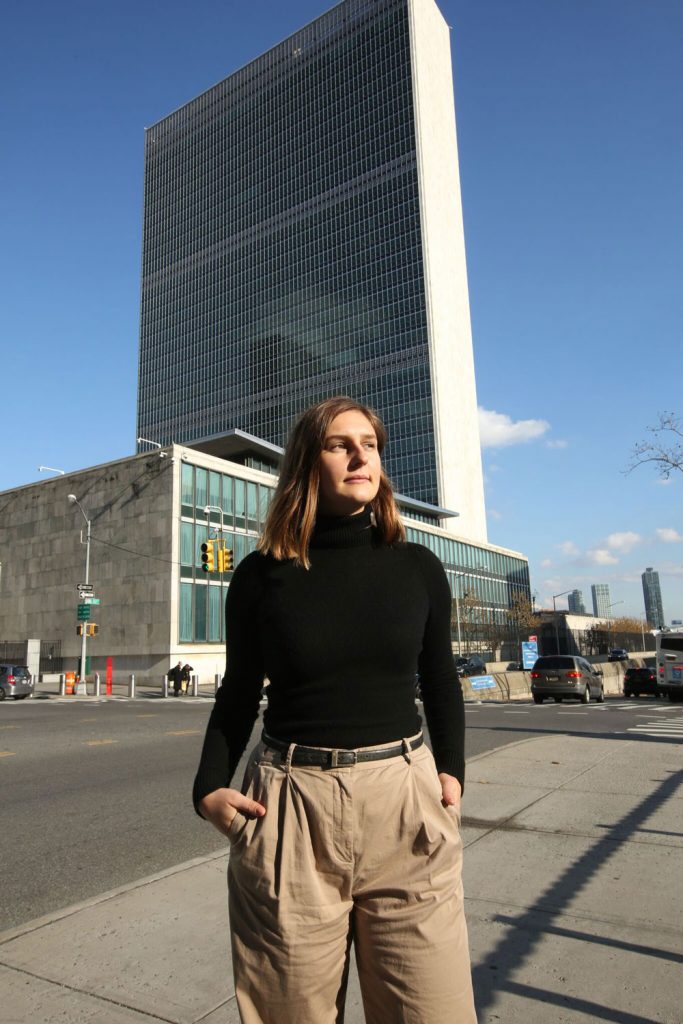What if someone told you it takes 2,700 liters of water to grow enough cotton for one T-shirt, an amount equal to one person’s drinking water for 900 days?
This was just one of the statistics about the fashion industry’s social and environmental effects shared at this month’s United Nations Department of Public Information/Non-Governmental Organizations briefing, “Fashion and Sustainability: Look Good, Feel Good, Do Good: Using Fashion as a Vehicle for Change.”
Kelly Roberts, assistant director in Fordham University’s Office for International Services and the University’s representative to the UN, says the goal was “to empower people with knowledge about the impact on our planet by the fashion industry and explore new ways as individuals, within our own institutions, within NGO communities, and in the wider education community to live a consciously fashionable lifestyle.”
The briefing, moderated by Patrick Duffy, founder of the Global Fashion Exchange, featured panelists from global organizations working to enact change in the industry and was followed by a fashion showcase, the first of its kind at the UN. Five designers presented sustainable clothing collections to an audience comprising designers and companies, students from multiple New York universities, NGOs, UN officials, and ambassadors.
Briana Ottoboni, Gabelli ’19, helped Roberts to plan the briefing with the NGO/DPI Executive Committee. A business student with a minor in fashion studies, she was shocked when she first heard facts like the one about cotton.
“I didn’t know anything about sustainability in the fashion industry at that point,” she admits, “so I did a lot of research.”
Then she did something about it.
Linking up with Fordham’s Social Innovation Collaboratory, Ottoboni worked with Carey Weiss, director of sustainability initiatives, to create a sustainable fashion practicum for the university with a team of students from diverse disciplines.

To focus on the lack of knowledge surrounding the harmful cycle within the fashion industry, the group is currently drafting a proposal for a new course allowing any student at Fordham to learn about sustainable fashion solutions. Ottoboni says it should be up and running next year.
In the meantime, Ottoboni also contributed to a new online course on sustainable fashion. The free course, conceived by Roberts and offered through the UN’s Global Compact-affiliated GOWI platform, leads participants through various topics, from sourcing and production to fashion’s sustainable future.
“Anyone can take it, which is nice,” Ottoboni explains, and the course is “written in a way that everyday consumers can understand.”
She says average people can do a lot to help the sustainable fashion movement. While brands can make changes to their own practices, she affirms, “people don’t realize how much power you have as a consumer.”
One way Ottoboni wields that power is by avoiding “fast fashion,” a term referring to companies releasing new clothing collections quickly and cheaply, leading to more textile waste and consumption of resources.
While some sustainable purchases cost more, Ottoboni suggests those with limited budgets can consider spending more on a garment that will last longer instead of buying new clothes more often.
She also believes that in the long term, “ethical sourcing and things like that will become a norm and become less expensive as demand increases.”
The enthusiastic audience at the UN briefing and showcase suggests the trajectory is already in motion, and Ottoboni is especially encouraged by this statistic: 65 percent of consumers are now actively seeking sustainable fashion.
— Chelsee Pengal
